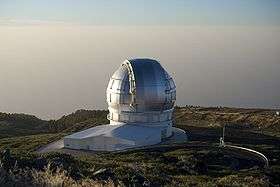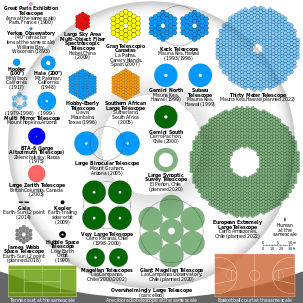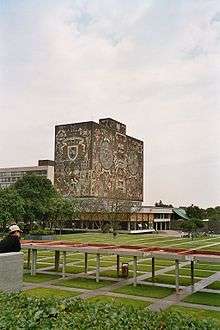Gran Telescopio Canarias
 Gran Telescopio Canarias, 2008 | |
| Alternative names |
GranTeCan |
|---|---|
| Observatory |
Roque de los Muchachos Observatory |
| Location(s) |
La Palma, Garafía, Spain |
| Coordinates |
28°45′24″N 17°53′31″W / 28.75661°N 17.89203°WCoordinates: 28°45′24″N 17°53′31″W / 28.75661°N 17.89203°W |
| Organization |
Instituto de Astrofísica de Canarias National Autonomous University of Mexico University of Florida |
| Observatory code |
Z18 |
| Altitude |
2,267 m (7,438 ft) |
| Built |
2002 |
| First light |
13 July 2007 |
| Telescope style |
Optical telescope Ritchey–Chrétien telescope Segmented mirror |
| Diameter |
10.4 m (34 ft 1 in) |
| Collecting area |
78.54 m2 (845.4 sq ft) |
| Focal length |
1 m (3 ft 3 in) |
| Mounting |
Altazimuth mount |
| Website |
www |
_OSM_map.jpg) Location of Gran Telescopio Canarias | |
The Gran Telescopio Canarias (GranTeCan or GTC) is a 10.4 m (410 in) reflecting telescope located at the Roque de los Muchachos Observatory on the island of La Palma, in the Canaries, Spain.
Construction of the telescope, sited on a volcanic peak 2,267 metres (7,438 ft) above sea level,[1] took seven years and cost €130 million (£112 million).[2] Its installation had been hampered by weather conditions and the logistical difficulties of transporting equipment to such a remote location.[3] First light was achieved in 2007 and scientific observations began in 2009.
The GTC Project is a partnership formed by several institutions from Spain and Mexico, the University of Florida, the National Autonomous University of Mexico,[4] and the Instituto de Astrofísica de Canarias (IAC). Planning for the construction of the telescope, which started in 1987, involved more than 1,000 people from 100 companies.[2]
It is the world's largest single-aperture optical telescope.[5] The division of telescope time reflects the structure of its financing: 90% Spain, 5% Mexico and 5% the University of Florida.
History

First light
The GTC began its preliminary observations on 13 July 2007, using 12 segments of its primary mirror, made of Zerodur glass-ceramic by the German company Schott AG. Later the number of segments was increased to a total of 36 hexagonal segments fully controlled by an active optics control system, working together as a reflective unit.[3][6] Its Day One instrumentation was OSIRIS. Scientific observations began properly in May 2009.[7]
Inauguration ceremony
The Gran Telescopio Canarias formally opened its shutters on July 24, 2009, inaugurated by King Juan Carlos I of Spain.[8] More than 500 astronomers, government officials and journalists from Europe and the Americas attended the ceremony.
MEGARA

MEGARA (Multi-Espectrografo en GTC de Alta Resolucion para Astronomia) is an optical integral-field and multi-object spectrograph covering the visible light and near infrared wavelength range between 0.365 and 1 µm with a spectral resolution in the range R=6000-20000. The MEGARA IFU (also called LCB, Large Compact Bundle) offers a contiguous field of view of 12.5 arcsec x 11.3 arcsec, while the multiobject spectroscopy mode allows observing 92 objects simultaneously in a field of view of 3.5 arcmin x 3.5 arcmin by means of an equal number of robotic positioners. Both the LCB and MOS modes make use of 100 µm-core optical fibers (1267 in total) that are attached to a set of microlens arrays (with 623 spaxels in the case of the LCB and 92x7 in the case of the MOS) with each microlens covering an hexagonal region of 0.62 arcsec in diameter.[9]
CanariCam
The University of Florida's CanariCam is a mid-infrared imager with spectroscopic, coronagraphic, and polarimetric capabilities, which will be mounted initially at the Nasmyth focus of the telescope. In the future, when the Cassegrain focus of the telescope is commissioned, it is expected that CanariCam will move to this focus, which will provide superior performance with the instrument.
CanariCam is designed as a diffraction-limited imager. It is optimised as an imager, and although it will offer a range of other observing modes, these will not compromise the imaging capability. The fact that CanariCam offers polarimetry and coronagraphy in addition to the more standard imaging and spectroscopic modes makes it a versatile and powerful instrument.
CanariCam will work in the thermal infrared between approximately 7.5 and 25 μm. At the short wavelength end, the cut-off is determined by the atmosphere—specifically atmospheric seeing. At the long wavelength end, the cut-off is determined by the detector; this loses sensitivity beyond around 24 μm, although the cut-off for individual detectors varies significantly. CanariCam is a very compact design. It is expected that the total weight of the cryostat and its on-telescope electronics will be under 400 kg. Most previous mid-infrared instruments have used liquid helium as a cryogen; one of the requirements of CanariCam is that it should require no expensive and difficult to handle cryogens.
CanariCam will use a two-stage closed cycle cryocooler system to cool the cold optics and cryostat interior down to approximately 28 K (−245 °C; −409 °F), and the detector itself to around 8 K (−265 °C; −445 °F), the temperature at which the detector works most efficiently. CanariCam is expected to be installed in 2010.[10]
OSIRIS
The IAC's OSIRIS (Optical System for Imaging and low Resolution Integrated Spectroscopy), is an "imaging and low resolution spectrograph with longslit and multiobject spectroscopic modes. It covers the wavelength range from 0.365 to 1.05 µm with a field of views (FOV) of 7 × 7 arcmin, and 8 arcmin × 5.2 arcmin, for direct imaging and low resolution spectroscopy respectively." It "provides a new generation of instrumental observation techniques such as the tunable filters, the charge-shuffling capability in the CCD detectors, etc."[11]
See also
- Other observatory sites
- Lists and comparisons
Gallery
 The dome of GTC under construction in 2002.
The dome of GTC under construction in 2002. The foundations under construction in 2000.
The foundations under construction in 2000. The initial digging in 2000.
The initial digging in 2000. The dome has opened for the night as the sun sets.
The dome has opened for the night as the sun sets.
References
- ↑ Rodríguez Espinosa, J. M.; Álvarez, P. (2002-02-05). "The GTC: STatus and Operation Plans" (PDF). RevMexAA. 16: 1–8. Archived from the original (PDF) on 2009-08-16. Retrieved 2009-07-24.
- 1 2 Moreno, Carlos (2009-07-25). "Huge telescope opens in Spain's Canary Islands".
- 1 2 "Tests begin on Canaries telescope". BBC. 14 July 2007.
- ↑ GTC faq GTC digital 8 January 2009
- ↑ Klotz, Irene (2009-07-24). "New telescope is world's largest ... for now".
- ↑ Giant telescope begins scouring space July 14, 2007
- ↑ El Gran Telescopio CANARIAS comienza a producir sus primeros datos científicos IAC Press release June 16, 2009 (Spanish)
- ↑ Heckle, Harold (July 24, 2009). "Huge Telescope Opens in Spain's Canary Islands". New York Times.
- ↑ "MEGARA instrument". guaix.fis.ucm.es. Universidad Complutense de Madrid.
- ↑ Hoover, Aaron (2009-07-24). "UF officials help inaugurate world's largest telescope". University of Florida News. University of Florida. Archived from the original on 2012-02-29.
- ↑ "Instruments Osiris". Gtc.iac.es. Gran Telescopio Canarias.
External links
| Wikimedia Commons has media related to Gran Telescopio Canarias. |
- Gran Telescopio Canarias
- GTC News
- Instituto de Astrofísica de Canarias (IAC)
- University of Florida CanariCam
- (in Spanish) Consejo Nacional de Ciencia y Tecnología de México
- (in Spanish) Instituto de Astronomía de la Universidad Nacional Autónoma de México
- CBC article—Giant Canary Islands telescope captures first light
- Images
- Gran Telescopo Canarias inauguration press dossier (in English)
- Merrifield, Michael. "Gran Telescopio Canarias". Deep Sky Videos. Brady Haran.
